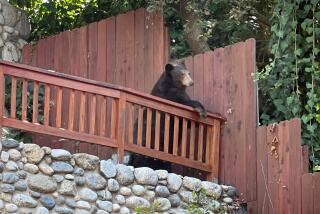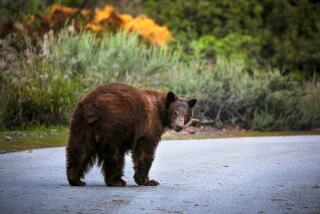Bark Beetle Numbers Declining
- Share via
A mysterious decline in the bark beetle population and the prospect of a wet winter have biologists cautiously predicting that the infestation that has felled tens of millions of pine trees from San Bernardino to Baja California may be nearing an end.
“If we get a lot of rainfall this coming winter, odds are good the beetle population will stay down,” said Tim Paine, an entomologist at UC Riverside. “If rainfall is very low, however, the trees will be back in the position they were before; there’s too many trees, and these beetles are real opportunists.”
Just how many trees might be spared because of the bark beetle decline won’t be known until U.S. Forest Service officials analyze the results of aerial surveys over the next several months. Trees continue to die, but the forests are experiencing lower mortality rates than last fall.
In the meantime, biologists are searching for explanations for this summer’s population crash of the pencil eraser-sized Western bark beetles that had been exploiting ongoing drought conditions and unnaturally dense forests to breed up to four generations of devastating swarms each year.
Some of the answers may lie in the catch basins of 46 3-foot-long bark beetle traps that have been set in forests throughout the state. Six of them, baited with bark beetle pheromones laced with insecticide, are in the San Bernardino National Forest, where more than one-third of the region’s 35 million trees are dead or dying.
Peering into a trap dangling from a wire near a stand of sickly ponderosa and Jeffrey pines shading the Barton Flats Campground, Forest Service entomologist Laura Merrill said, “Earlier this year, we were getting half a cup full of beetles a week. Now, it’s a few dozen.”
The bark beetle has always been endemic in the mountains. But years of fire suppression, increasingly dense forests and warm winters triggered an unprecedented beetle population.
Healthy pines fight the insects by drowning them with sap. But in the drought-stricken mountains, hungry beetles land on stressed trees and emit pungent pheromones that attract new swarms. Now, however, something is keeping the bugs in check.
“I think the worst is over,” said Merrill, standing in the campground about 15 miles south of Big Bear Lake. “The population of Western bark beetles, our most aggressive insect, has dropped significantly for the first time in three years.
“Why that is so, however, remains a mystery,” she added. “It’s still warm enough for plenty of breeding days, and they haven’t eaten themselves out of trees. Perhaps natural controls are kicking in, such as predators and parasites that prey on bark beetles. We just don’t know.”
The traps Merrill tends are designed to take advantage of the beetles’ life cycles.
The insects bore into the bark and feast on the moist inner core, where trees store and transport nutrients from roots to needles. They also carve egg galleries, where larvae hatch, mature and emerge to infect other trees.
“To bark beetles, which can’t see too well, the traps resemble tree trunks,” Merrill said. “Once they get a whiff of the pheromones, which smell like turpentine, they say, ‘Wow! This smells like a tree under attack -- a perfect place to find mates and lay eggs.’ ”
An aerial survey conducted by Forest Service forest health protection expert Jeff Mai in June confirmed the information that Merrill has been collecting on the ground.
“Overall, tree mortality is still increasing, but at a reduced rate,” Mai said. “Yet we’re still in a drought, and our forests are unnaturally dense because of years of fire suppression.”
Only six months ago, forest officials were forecasting that up to 50% of the trees in the 800,000-acre San Bernardino National Forest would be dead or dying by this time amid exponential bark beetle population explosions. Now they’re revising their estimates downward.
Now they’re worried that the falling bark beetle population will allow officials and the public to become complacent about the threat of fire. The loss of millions of trees has spurred officials to call for better firefighting techniques and prompted property owners to clear brush or fell trees to protect their mountain homes.
“We are still facing a significant risk of a wildfire this fall,” said Jon Regelbrugge, vegetation management team leader for the San Bernardino National Forest. “There’s a lot of mortality that’s already happened, and not that many trees that have been removed. All it would take is ignition in a bad place on the wrong day, and we could be in a heck of a problem.”
Richard Minnich, chairman of the department of earth sciences at UC Riverside, believes that scenario “will stay with us, big time, until we thin out the stands. Right now, it’s scary out there.
“But with oceans warming up in the equatorial South Pacific, we are likely to kick into a wet year,” he said. “If that happens, it’ll stop this unprecedented tree mortality episode in its tracks.”
Merrill was less optimistic.
Adjusting the placement of the pheromone lure in her beetle trap, she said, “If you’re going to bet on something, bet on the insects.”
More to Read
Sign up for Essential California
The most important California stories and recommendations in your inbox every morning.
You may occasionally receive promotional content from the Los Angeles Times.











